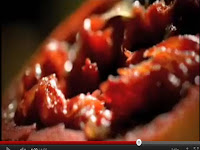·Camera shots/angles/movements
·Lighting
·Sound
·Mise en scene
·Editing
I will be focusing on how the clip from TV Drama 'Hotel Babylon' represents different ethnicities through techniques such as camerawork and mise en scene, lighting and sound.
The scene starts with a conversation between two black men. One is portrayed as professional and fairly affluent, which is shown through his costume as he is wearing a dark suit and tie. The latter is stereotypically Jamaican, as he is shown to be wearing bright colours - green and red. This is a culturally significant sign, and are colours which relate to the Jamaican flag, and so this connotes (Roland Barthes, 1977) his ethnic background.
In addition, he talks about "booze, girls, ganja" which stereotypes the Jamaican ethnicity again. Mise-en-scene is also used to construct a representation of Jamaican people, such as the costume and props, as he is wearing plenty of jewellery and has dreadlocks - which is a well known appearance of this ethnic type.
However, the camera shots are also used to create a different representation of their ethnicity - one that goes against the stereotype. The first man (Benjamin) is shown to be less stereotypically involved in illegal activities/women, etc. Reaction shots show Benjamin looking uncomfortable in the other man's presence and sounding less interested in the women he is describing, but rather in the man himself, which is shown as he says - "You're looking good." Here, Hotel Babylon does not portray all Jamaican men as interested in "girls" or "ganja."
Two female maids enter during scene two. They are clearly foreign (as shown through their accents) - perhaps Eastern European. They are represented as quite exotic (Alvarado et al. 1987) as they perform a 'strip tease' for a customer at the hotel. The music played in the background sounds suspicious, but also sultry, hinting at the exoticness of their ethnicity. The camera also supports this idea, as when they first enter, the camera pans upwards to show their faces, but mostly focuses on their waist and above (medium mid shots) which accentuates their femininity. Non-diegetic sound is also used, as the song played in the background is quite suggestive and the words 'Girls! Girls!' are repeated as they perform for the client at the hotel. The lighting is also fairly dim, and suggests the shady atmosphere. One of the maids is shown to be more 'innocent.' The camera shots portray this as she looks disgusted at the thought of what she will have to do. Also, she is wearing a cross, which is a signifier and brings with it the connotations of religion and therefore morals. As she is presented as Eastern European, this is an effective use of representation, as that is an area of the world that is closely tied to religious activities.
The client himself looks to have quite an oriental ethnic background, and so presented as a stereotypical 'Japanese tourist' as he appears not to speak a word of English, but lots of money to spend. Camera composition shows this as the most angles are close-ups of his face - wide eyes and open mouth suggest not fully grasping the English language. The camera then zooms in on two piles of cash lying on the table. He is also the one who turns on the sound system, which associates him with technology, again representing Japanese men as affluent, immoral but also very knowledgeable in areas such as technology.
Later on, two white people are shown walking into a kitchen. They are professionally clothed (one male, one female.) They appear Aryan, and are in control over the foreigners, which is an example of mis en scene to represent the idea of white people being superior in their own country.
The taller of the chefs is insulted as an 'English cretin' by the other. This man is heavily accented, and appears to be of a different ethnic background, such as Italian. This is shown by his actions, e.g. he touches his fingers to his mouth and blows a kiss, which is a culturally identifiable motion/ cultural signifier.
They are also shown to be very proud of their heritage, as many of the insults they fling at each other are about race/culture. Also, the mis-en-scene used with their chef hats and uniform show that they are proud about their food (especially their countries food.) “...A more discerning pallet...” Diegetic sound is used when the first chef (Italian) picks up a large knife. The ‘slicing’ sound of the knife is added over the scene, and is very loud. This has the effect of representing men from certain areas of the world as proud, and therefore more likely to be violent. The music in this scene also adds tension as the tempo increases and so does the volume, during their fight.
During the very last scene, eyeline matches are used between the maid who earlier performed the strip tease, and another woman who is shocked to find out what has been going on. As the latter also looks Oriental, this extract uses camera shots to portray conflicting representations of ethnicity. Earlier, people of Chinese/Japanese descent were shown to be rich, immoral tourists. However, in this scene, the woman looks shocked as she sees the maid doing up her buttons after leaving the hotel room. The costume she is wearing shows she is quite well off, however, the camera jumps from the maid walking away, to her extremely shocked and disgusted face, showing that she doesn’t approve of what has been going on. In this extract, not all Oriental people are shown in a negative light.






































